Plants are organisms sharing the following derived characteristics:
- Autotrophic, using CO2 as the source of carbon for organic compounds
- Photosynthetic using chlorophylls a and b, plus several "accessory pigments," to capture solar energy.
- Generally non-motile, with some exceptions for male gametes.
- Presence of persistent embryonic tissue (meristem) capable of indeterminate growth throughout life.
- Development from multicellular embryos in which a reproductive cell (ovum) is surrounded by nonreproductive tissue.
Origin of Plant Kingdom = origin of multicellular embryos.

BRYOPHYTES
Bryophytes are plants with multicellular embryos but no vascular tissues (xylem or phloem).
Because they lack vascular tissues or true roots, bryophytes cannot be
anchored very strongly in the soil or grow very tall.
Neither water nor
nutrients can be transported from one plant part to another except by
diffusion. This restricts bryophytes to small sizes and moist habitats;
it also means that all parts of the plant must carry out their own
photosynthesis.
Bryophytes probably evolved from green algae. All
bryophytes have well-marked alternation of generations, with the gametophyte
phase dominant.
Bryophytes include mosses, liverworts, and hornworts.
Bryophytes
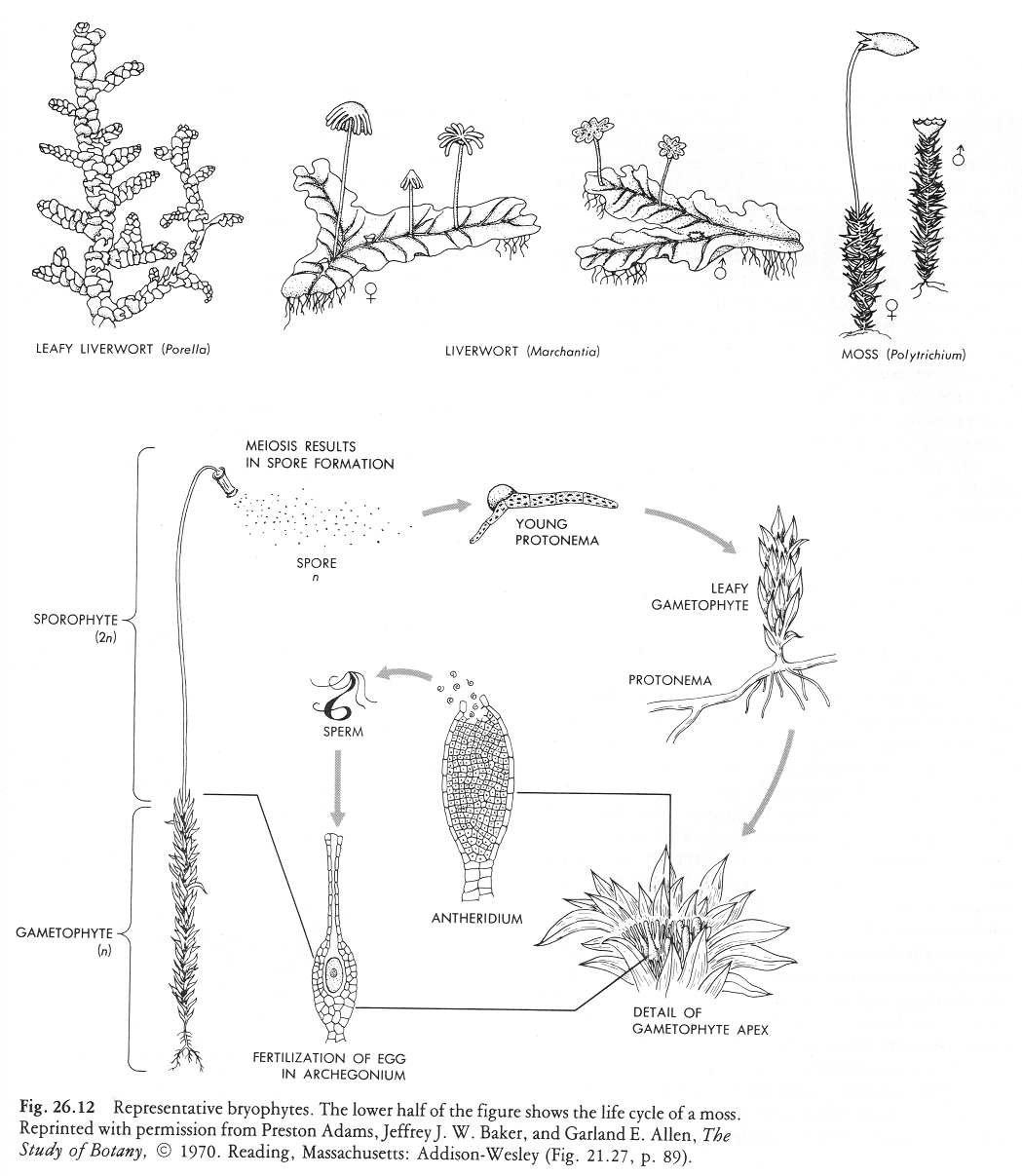

Video: Airborne sperm in Liverworts
VASCULAR PLANTS WITHOUT SEEDS
Vascular plants (tracheophytes) are plants with vascular tissue
that helps transport materials within the plant.
Vascular tissue also provides support, holds plants erect, and allows
the plant to grow much taller. (Some tropical trees grow up to 73 meters or 240 feet high, the height of a 20-story building.)
Vascular tissues (xylem and phloem) conduct fluid through cells
with cell walls made stiff by the compound lignin. The stiff cell walls (wood) allow plants to grow
taller and erect. By conducting fluids, vascular tissues allow plants to grow in new habitats:
- Xylem allows above-ground plant parts to receive water and nutrients absorbed by the roots.
'Xylem' is the Greek word for wood. It consists mostly of the empty cell walls of dead cells.
- Phloem allows parts that do not photosynthesize to receive sugars and other
products from the green, photosynthesizing parts. This
permits ROOTS to grow underground where sunlight does not penetrate,
enabling water absorption deep underground and thus enabling growth
in habitats were it isn't always wet at the surface. Phloem contains living cells.
Early vascular plants had dichotomous branching. Stems were photosynthetic, with no true leaves.
Lepidophytes and arthrophytes developed simple leaves (microphylls) with a single vein or vascular bundle.
Pterophytes developed larger leaves (megaphylls) with branching veins.
Early evolution of vascular plants


Early vascular plants (Rhyniophyta and Psilophyta):
The earliest vascular plants, like Rhynia
and Asteroxylon, lived in moist, swampy places
during the Silurian period.
Dichotomous (two-fold) branching characterized all plant parts.
Much of each plant grew out horizontally, but some parts turned upward
and grew erect. No true leaves were present; stems were green and
photosynthetic.
Surviving relatives include only a few living genera
(Psilotum, Tmesipterus) with spore-forming structures (sporangia)
terminal in position. Stems are green and photosynthetic; no true leaves or
roots are present. Stomates (breathing pores) are distributed over the outside surface of
the stems.
Lepidophyta (lycopods): Club mosses and their relatives.
True roots are present and dichotomously
branched. Leaves (mostly small) are microphylls— each has a
single vein in the middle, and the vascular bundle is not interrupted
where this vein arises. Some leaves bear reproductive sporangia in the
angle of attachment (axillary position). Modern lycopods are all small
plants, but some Carboniferous lycopods grew to tree-like heights.
Arthrophyta or Sphenopsida: Horsetails, with spore-forming parts
grouped in a cone-like structure at the top, and spores hidden beneath
scale-like sporophylls. Small leaves are arranged in tiers or whorls;
true roots are present. Equisetum is the only living genus.
Pterophyta: Ferns and fernlike plants, with true roots. Leaves are
megaphylls— each has many branching veins, and the vascular
bundle is interrupted by a leaf gap where the main vein arises.
Leaves carry sporangia on their lower surfaces or their margins. Life
cycle has a dominant sporophyte.

Lepidophyta
Arthrophyta:
Horsetail or "scouring rush"
(Equisetum)

| 
|
F e r n s ( Pterophyta)


VASCULAR PLANT PARTS

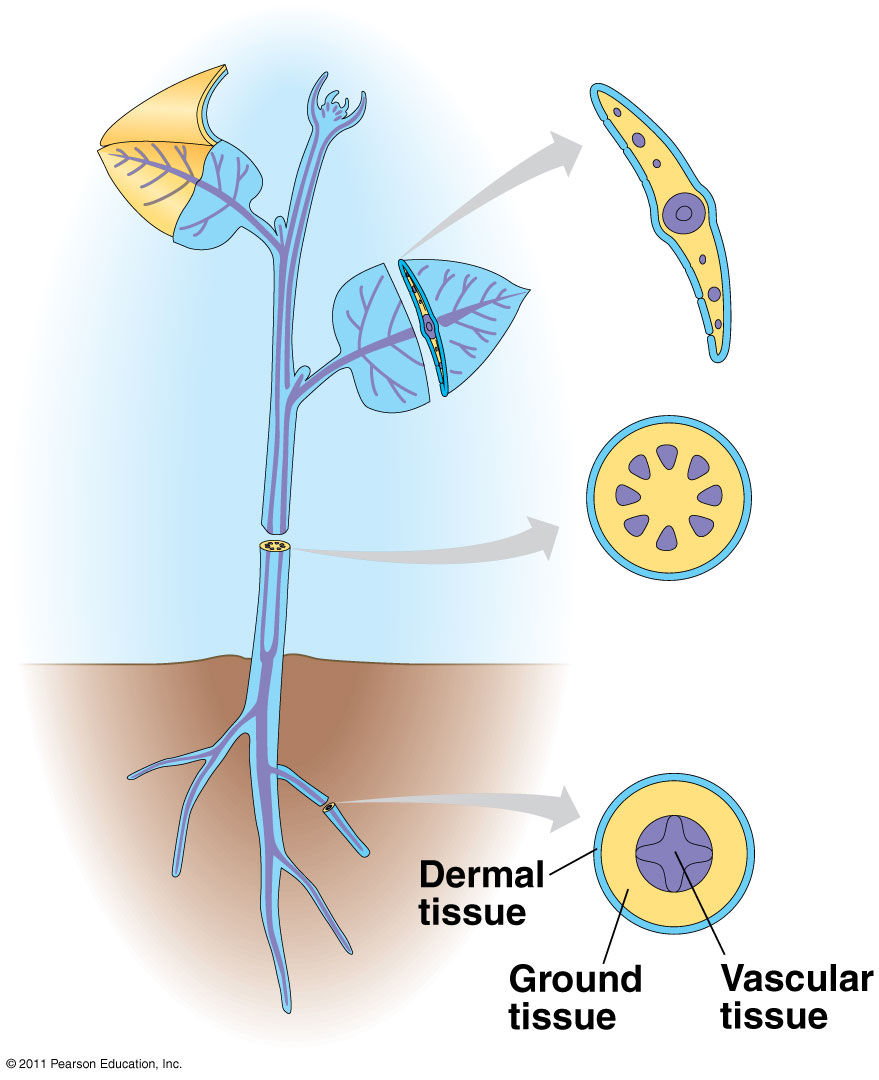
XYLEM
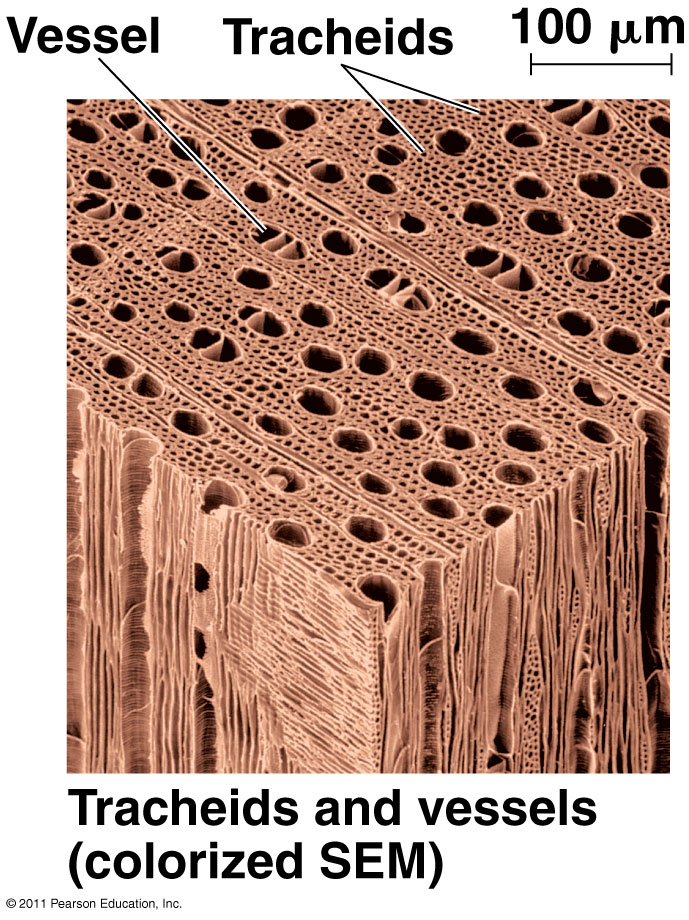
PHLOEM
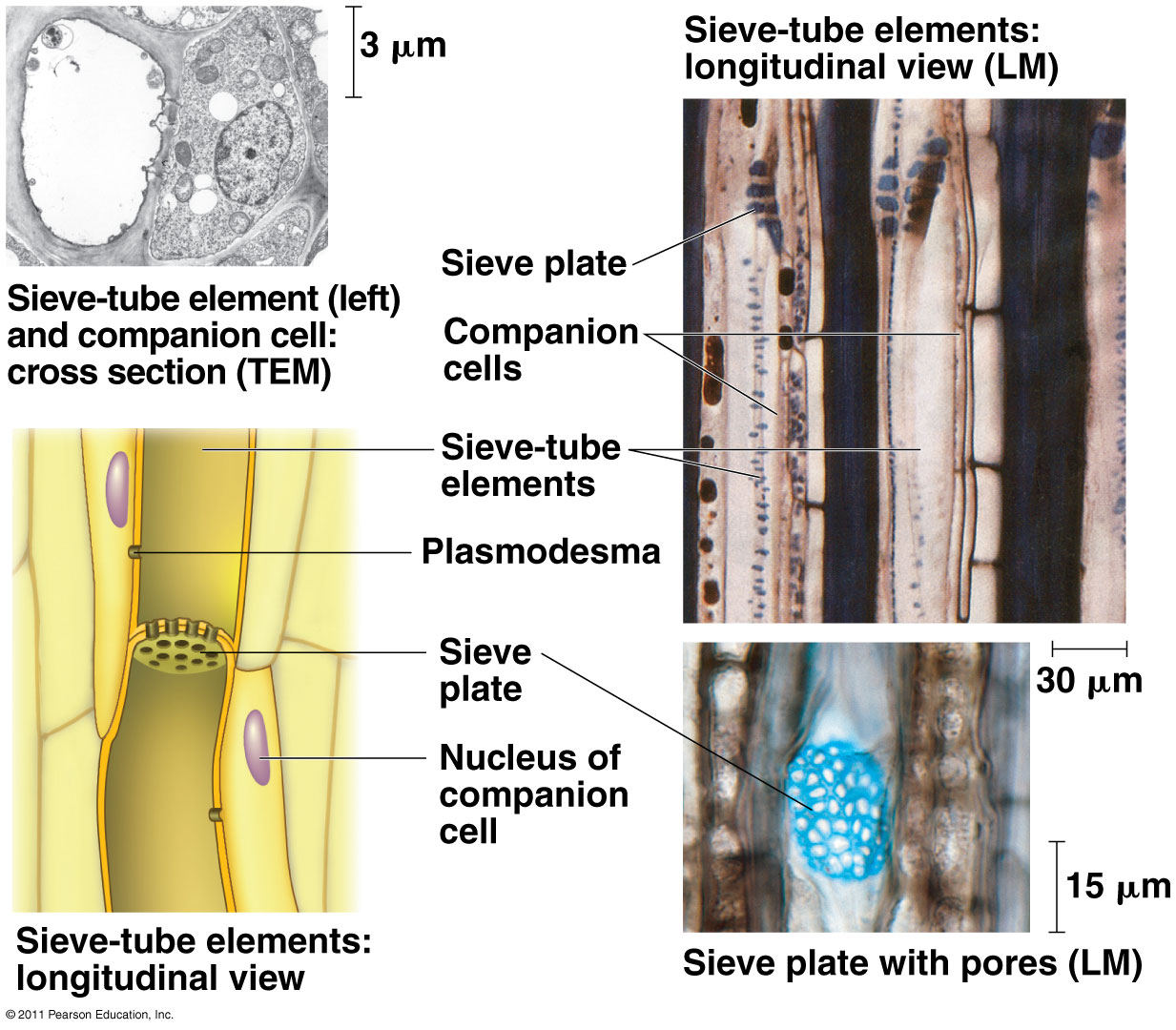
STEMS

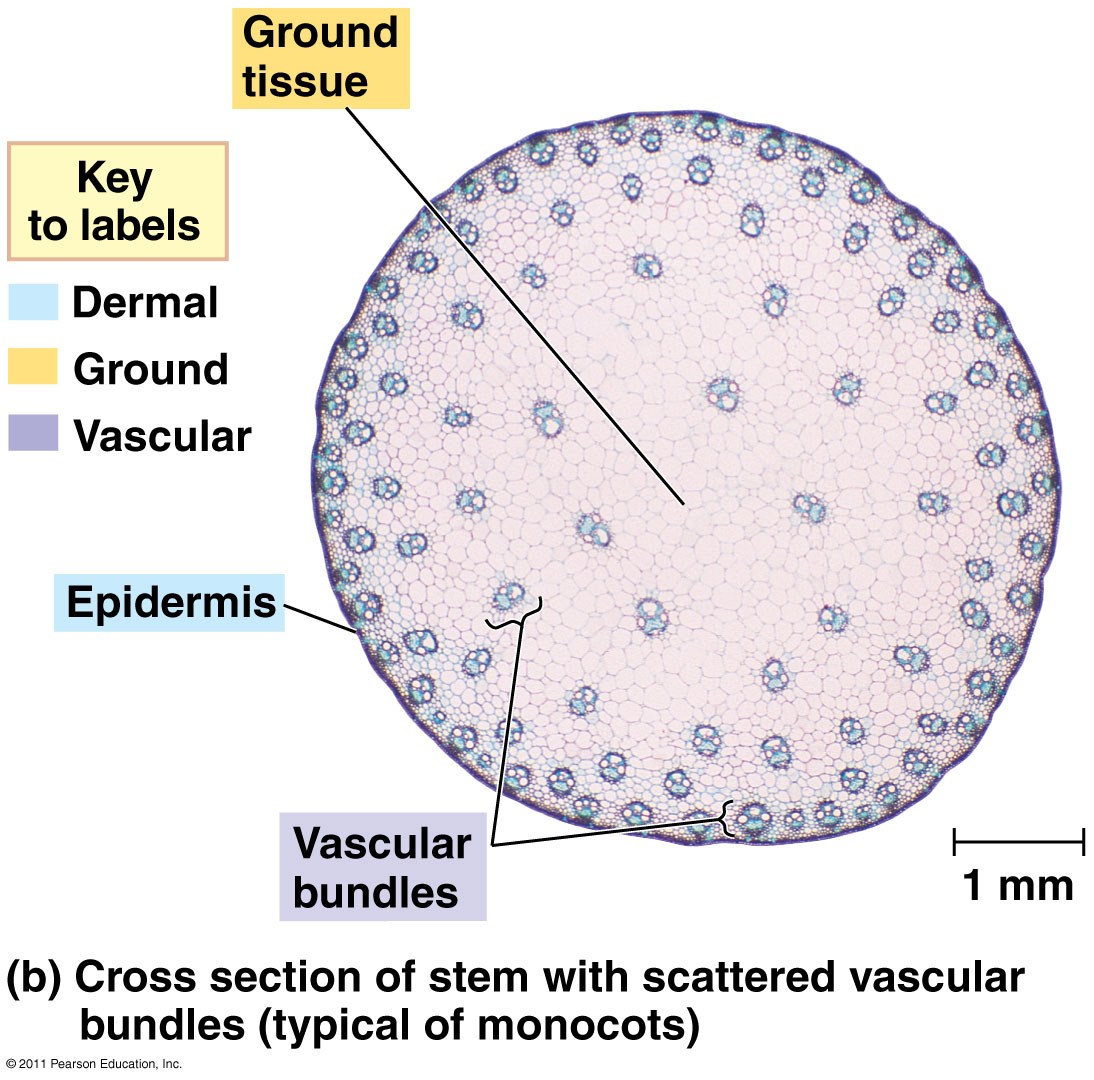
LEAVES

NUTRITION and TRANSPORT in vascular plants:
Leaves are the principal organs of photosynthesis in most plants.
The light reactions of photosynthesis take place most efficiently in the
palisade layer, and the light-independent (or "dark") reactions
in the spongy mesophyll.
- Leaves are made of:
- Upper epidermis, coated with a waxy cuticle.
- Palisade layer, containing the highest density of
chloroplasts. The "light" (light-dependent) reactions of
photosynthesis are most efficient here.
- Spongy mesophyll: The "dark" (light-independent)
photosynthesis reactions are most efficient here because
air spaces facilitate gas exchange.
- Veins (extensions of xylem + phloem) run through the
spongy mesophyll layer.
- Lower epidermis, coated with a waxy cuticle, contains
pores for gas exchange called stomates or stomata.
- Phloem transport: The phloem tissue transports photosynthetic
products from the leaves to other parts of the plant, principally
downward through the stem. The principal transport cells in phloem are
seive tube cells.
- Xylem and transpiration:
- Water and dissolved minerals
(ions, including K+, Ca2+, Mg2+,
NO3-, PO43-) ascend
from roots through stems to upper parts of the plant, traveling
through tube-like tracheids of the xylem.
- Loss of water from leaves is called transpiration.
- The ascent of sap seems to be governed largely by
transpiration pull, or reduced pressure from above,
a process requiring long, unbroken chains of fluid with no
air bubbles. Root pressure also helps a bit.
SEED PLANTS: GYMNOSPERMS, ANGIOSPERMS
Seeds are easily dispersed structures developed from a zygote and
enclosing an embryonic sporophyte.
All plants with seeds also possess megaphylls,
leaves with branched veins whose bases interrupt the vascular
bundle to form a leaf gap.
Gymnosperms: Vascular plants with naked seeds, borne naked on
the surface of reduced, scale-like leaves and not enclosed within ovules
(as in angiosperms).
Vascular plants with naked seeds ("gymnosperms") are placed in five or more phyla
(divisions): seed ferns (Pteridospermophyta), cycads (Cycadophyta),
ginkgos (Ginkgophyta), conifers (Coniferophyta), and Gnetophyta.
Seed ferns (Pteridospermophyta): Extinct plants with large,
fern-like leaves, but reproducing by seeds; occasionally growing to
the height of small trees. Devonian to Jurassic in age, dominant
during the Carboniferous (when they formed great coal swamps). Believed
close to the ancestry of other seed plants.
Cycads (Cycadophyta): Short, thick-stemmed plants with a crown
of large fern-like or palm-like leaves. Seeds borne together in a structure
resembling a large pine cone. Flourished during the Mesozoic era; only
a few tropical and subtropical genera persist today.
Ginkgos (Ginkgophyta): A mostly Mesozoic group with one living
species (Ginkgo biloba, an ornamental tree with fan-shaped leaves).
Conifers (Coniferophyta): The most familiar and economically important
gymnosperms, including pines, spruces, firs, etc. Leaves are typically
scale-like or needle-like, with reduced surface area. Seeds are borne in
cone-like aggregates.
Gnetophyta: This group includes only three living genera (Gnetum,
Ephedra, Welwitschia), which differ greatly. All share a partially
enclosed type of seed that approaches the angiosperm condition but was
probably derived independently.
Seed plants



Conifers

  
Welwitschia
Angiosperms


Angiosperms (flowering plants) have seeds enclosed in an ovary.
Flowers include ovaries and surrounding structures.
Many flowers are fertilized by insects.
Angiosperms probably
evolved in response to selection by insects.
Ripened ovaries make up a fruit.
Roots, stems, and leaves reach maximum complexity
and diversity within the angiosperms.
Angiosperms are divided into
"dicots" (Dicotyledonae) and "monocots" (Monocotyledonae).
Flower: An ovary, together with surrounding reproductive structures:
- Petals and sepals
surround and protect the other flower parts,
especially in undeveloped flowers. In many species, these parts may have
colors or odors that attract insects or other species that pollinate
the plant or disperse its seeds.
- Male flower parts include stamens, each made of a
filament and a
pollen-producing anther. Pollen grains
contain male gametophytes.
- Female flower parts include stigma (whose sticky surface
catches pollen), style (a stalk-like part supporting the stigma),
and ovary, enclosing one or more ovules within modified
leaves called carpels. Each ovule develops into an 8-celled
gametophyte containing 1 egg, 2 polar nuclei, and 5 other cells.
- "Complete" flowers have all the parts listed above, but many
species have separate male flowers and female flowers.
Fertilization: First, a thin, long pollen tube grows from the
pollen grain down the style. Two nuclei (tube nucleus and generative
nucleus migrate down the pollen tube as it grows. The generative nucleus
then divides into two sperm cells: one fertilizes the egg (syngamy
or true fertilization; the other fuses with the 2 polar nuclei to form
a triploid (3N) endosperm, containing stored food that supports the
embryo later. This so-called double fertilization is characteristic
of all angiosperms. After fertilization, the new embryo and its endosperm
and protective coverings make up a seed.
Fruits: One or more ripened ovaries together constitute a fruit,
enclosing one to many seeds. Many fruits are eaten (and their seeds dispersed)
by animals; other seeds are dispersed by wind, etc.
Types of fruits
Flowers that mimic bees
Roots: Absorptive parts, usually underground. They contain, from the
outside inward:
- Epidermis, from which absorptive root hairs develop.
- Cortex, often a thick layer.
- Endodermis, containing a waterproof Casparian strip.
- Vascular bundles, with xylem, phloem, and cambium surrounded
by a pericycle.
Stems: Supportive structures which contain, from the ouside inwatrd:
- Epidermis
- Cortex (bark)
- Vascular bundles, each containing phloem and xylem,
along with some persistently embryonic tissue called cambium.
- Pith (not always present) in the innermost parts of the stem.
Leaves: The major photosynthetic organs,
are described here.
Specialized leaves: Mimosa sensitive plant
Class Dicotyledonae ("dicots", Magnoliophyta): Angiosperms with a
seed containing two "seed leaves" (cotyledons) in which food is
stored. (The two halves of a dried peanut are a familiar example.)
- Flower parts are usually in multiples of 4 or 5.
- Veins in leaves and petals branch to form net-like patterns.
- Vascular bundles usually arranged in a circular ring.
- Includes the majority of angiosperms: buttercups (considered
primitive), roses, beans (and other legumes), daisies, oaks, maples,
apples, oranges, peaches, melons, and many others.
Class Monocotyledonae ("monocots," Liliophyta): Angiosperms with a
seed containing only one "seed leaf" (cotyledon) in which food is stored
(such as a kernel of corn, which cannot be divided into halves).
- Flower parts are usually in multiples of 3 or 6.
- Leaves and petals have parallel veins that branch only occasionally.
- Vascular bundles usually scattered throughout cross-section of stem.
- Includes the more advanced angiosperms: orchids, lilies, palms,
and grasses (including wheat, corn, rice, and other cereal grains).
|
· · · • • • • •
· · ·
Click here for the
Check-In questions
—— Rev. Nov. 2020 ——
|

























